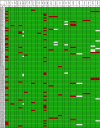Distinct patterns of mutations occurring in de novo AML versus AML arising in the setting of severe congenital neutropenia
- PMID: 17494858
- PMCID: PMC1975847
- DOI: 10.1182/blood-2007-03-081216
Distinct patterns of mutations occurring in de novo AML versus AML arising in the setting of severe congenital neutropenia
Abstract
Severe congenital neutropenia (SCN) is an inborn disorder of granulopoiesis. Like most other bone marrow failure syndromes, it is associated with a marked propensity to transform into a myelodysplastic syndrome (MDS) or acute leukemia, with a cumulative rate of transformation to MDS/leukemia that exceeds 20%. The genetic (and/or epigenetic) changes that contribute to malignant transformation in SCN are largely unknown. In this study, we performed mutational profiling of 14 genes previously implicated in leukemogenesis using 14 MDS/leukemia samples from patients with SCN. We used high-throughput exon-based resequencing of whole-genome-amplified genomic DNA with a semiautomated method to detect mutations. The sensitivity and specificity of the sequencing pipeline was validated by determining the frequency of mutations in these 14 genes using 188 de novo AML samples. As expected, mutations of tyrosine kinase genes (FLT3, KIT, and JAK2) were common in de novo AML, with a cumulative frequency of 30%. In contrast, no mutations in these genes were detected in the SCN samples; instead, mutations of CSF3R, encoding the G-CSF receptor, were common. These data support the hypothesis that mutations of CSF3R may provide the "activated tyrosine kinase signal" that is thought to be important for leukemogenesis.
Figures



Similar articles
-
Ultra-Sensitive CSF3R Deep Sequencing in Patients With Severe Congenital Neutropenia.Front Immunol. 2019 Feb 28;10:116. doi: 10.3389/fimmu.2019.00116. eCollection 2019. Front Immunol. 2019. PMID: 30891028 Free PMC article.
-
Mechanisms of leukemic transformation in congenital neutropenia.Curr Opin Hematol. 2019 Jan;26(1):34-40. doi: 10.1097/MOH.0000000000000479. Curr Opin Hematol. 2019. PMID: 30431463 Free PMC article. Review.
-
Effect of the unfolded protein response and oxidative stress on mutagenesis in CSF3R: a model for evolution of severe congenital neutropenia to myelodysplastic syndrome/acute myeloid leukemia.Mutagenesis. 2020 Dec 1;35(5):381-389. doi: 10.1093/mutage/geaa027. Mutagenesis. 2020. PMID: 33511998 Free PMC article.
-
A Truncated Granulocyte Colony-stimulating Factor Receptor (G-CSFR) Inhibits Apoptosis Induced by Neutrophil Elastase G185R Mutant: IMPLICATION FOR UNDERSTANDING CSF3R GENE MUTATIONS IN SEVERE CONGENITAL NEUTROPENIA.J Biol Chem. 2017 Feb 24;292(8):3496-3505. doi: 10.1074/jbc.M116.755157. Epub 2017 Jan 10. J Biol Chem. 2017. PMID: 28073911 Free PMC article.
-
[Gene Mutation and Acute Leukemia Transformation of Severe Congenital Neutropenia- Review].Zhongguo Shi Yan Xue Ye Xue Za Zhi. 2017 Oct;25(5):1580-1584. doi: 10.7534/j.issn.1009-2137.2017.05.053. Zhongguo Shi Yan Xue Ye Xue Za Zhi. 2017. PMID: 29070147 Review. Chinese.
Cited by
-
High throughput digital quantification of mRNA abundance in primary human acute myeloid leukemia samples.J Clin Invest. 2009 Jun;119(6):1714-26. doi: 10.1172/JCI38248. Epub 2009 May 18. J Clin Invest. 2009. PMID: 19451695 Free PMC article.
-
Prevalence of mutations in ELANE, GFI1, HAX1, SBDS, WAS and G6PC3 in patients with severe congenital neutropenia.Br J Haematol. 2009 Nov;147(4):535-42. doi: 10.1111/j.1365-2141.2009.07888.x. Epub 2009 Sep 22. Br J Haematol. 2009. PMID: 19775295 Free PMC article.
-
Mutations in the SRP54 gene cause severe congenital neutropenia as well as Shwachman-Diamond-like syndrome.Blood. 2018 Sep 20;132(12):1318-1331. doi: 10.1182/blood-2017-12-820308. Epub 2018 Jun 18. Blood. 2018. PMID: 29914977 Free PMC article.
-
Prevalence of a new auto-activating colony stimulating factor 3 receptor mutation (CSF3R-T595I) in acute myeloid leukemia and severe congenital neutropenia.Haematologica. 2013 May;98(5):e62-3. doi: 10.3324/haematol.2013.085050. Epub 2013 Mar 18. Haematologica. 2013. PMID: 23508011 Free PMC article. No abstract available.
-
Pathophysiology and management of inherited bone marrow failure syndromes.Blood Rev. 2010 May;24(3):101-22. doi: 10.1016/j.blre.2010.03.002. Epub 2010 Apr 24. Blood Rev. 2010. PMID: 20417588 Free PMC article. Review.
References
-
- Alter B. Inherited bone marrow failure syndromes. In: Nathan DG, Orkin SH, Look AT, Ginsburg D, editors. Hematology of Infancy and Childhood. 6th ed. Philadelphia, PA: WB Saunders; 2003. pp. 280–365.
-
- Rosenberg PS, Greene MH, Alter BP. Cancer incidence in persons with Fanconi anemia. Blood. 2003;101:822–826. - PubMed
-
- Freedman MH, Bonilla MA, Fier C, et al. Myelodysplasia syndrome and acute myeloid leukemia in patients with congenital neutropenia receiving G-CSF therapy. Blood. 2000;96:429–436. - PubMed
-
- Smith OP, Hann IM, Chessells JM, Reeves BR, Milla P. Haematological abnormalities in Shwachman-Diamond syndrome. Br J Haematol. 1996;94:279–284. - PubMed
Publication types
MeSH terms
Substances
Grants and funding
LinkOut - more resources
Full Text Sources
Medical
Molecular Biology Databases
Research Materials
Miscellaneous

